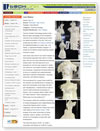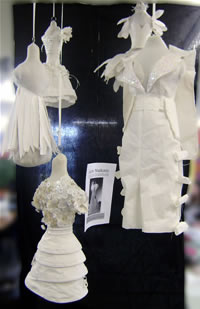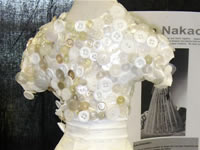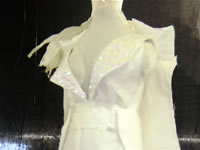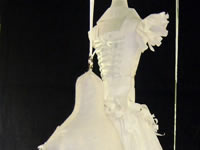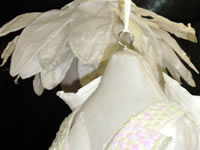Jum Nakao
Level: Year 12
School: Wellington High School
Teacher: Kylie Merrick
Category: Teaching Strategy
Student Workbooks: Ellen | Megan
Fashion Textiles Technology teacher Kylie Merrick takes advantage of the exhibitions relevant to her students' learning and which are easily accessible in the city. One such exhibit was the 2008 Jum Nakao exhibition at the NewDowseGallery in Lower Hutt. Jum Nakao, a Japanese-Brazilian designer, is known for his fashion shows featuring models dressed in paper.
Kylie plans new units for her senior classes so that students approach their work in a fresh way, and are not overly influenced by previous student work. She had planned to do a wearable art unit and was inspired to create one based on Jum Nakao's themes, materials, and outcomes, noting that this would allow her to focus on creativity and experimentation, alternative materials manipulation, recycling resources, and fashion drawing.
She considered him a good 'artist model' for her students and wanted them to analyse his work and incorporate some ideas into their own development. "I wanted them to look at how his work pushed the boundaries of fashion, and to question where it fitted: Was it art? Was it fashion? Was it wearable art? Where was it on the continuum?"
The students visited the exhibition (consisting of mostly photographs) and independently they researched Nakao's work in books, magazines, and the internet, where they could view videos of his fashion shows. Their analysis of his work, particularly of ideas, materials, colours, shapes, and themes served as a foundation to base their own development.
The class was given a brief – to make a mannequin and design an outfit for it using paper as the main medium, and the colour white. The project also had to conform to a recycling theme which, says Kylie, is the true nature of wearable art. Students were supplied with calico and stuffing for the mannequins, but nothing else was paid for, as they used donated paper and were encouraged to be resourceful in finding any other items they wanted. They were required to note in their workbooks where they had found their materials – "this wire was in the science room and no-one was using it," or "this glitter was left over from another project I did". However, Kylie did break the 'no buying' rule for a student who, after exhausting home and school supplies for 100 buttons, couldn't source more free ones in the time available.
To explore various ways of using paper and encourage creativity, Kylie had the class spend a week working on different activities with the material, where they ripped, cut, layered, rolled, wove, folded, plaited, fanned and made holes in paper, did origami, and machine/hand-sewed paper. "It was a great technological process for them because paper is such a different medium. It was interesting watching them do that and document it as they went along." The paper was quite fibrous so students making layers had to allow for its lack of flexibility, and there was a lot of trial-and-error as they experimented with it to determine how to achieve a particular effect.
Massey University School of Design, next door to Wellington High, provided another opportunity for students to observe fashion created out of paper when they saw the paper garments created by groups of Year 1-4 university students for their 24 Hour Fashion Challenge. The class spent several hours analysing the outcomes, prompted by a worksheet asking them about silhouette, construction, shape, theme, and how a design might be reproduced. The purpose of this exercise, Kylie says, was for students to practise their observational/analytical skills, to add to their background knowledge, and to help their own work as they considered what they could do with paper.
Kylie introduced a fashion-drawing aspect to the unit, but 'upped it a level' to encourage students to concentrate on communicating their ideas. Each student was allocated ten pieces of black paper and a white pencil to draw their concept ideas, and were instructed that they couldn't rub out any pencil markings. Some found this exercise quite difficult but Kylie says it was a good way to focus them on the task and pushed their work to a higher level. Instead of sketching something, not liking it, and throwing it away, students were really thinking about what they did, she says, and only required extra paper when they had too many great ideas. This was a successful part of the project and also helped students think about the possibilities of using paper in new and varied ways.
Each student chose a theme for her mannequin's outfit, and inspiration ranged from snow, flowers, and animals to contemporary music. The mannequins were limited in height to 60 cm, partly due to storage requirements and also to ensure that everyone fully completed their work in time. Some students went beyond making a basic mannequin and, for example, drafted a pattern to incorporate more detail in shaping to create arms and a bust.
The students trialled a variety of manipulation techniques, the only restriction being that they couldn't construct the costumes with glue. They made patterns for their costumes and modelled some aspects to ensure they worked as expected. Kylie says that the students found working with paper an interesting and challenging task because it is so different from fabric, and because of its ripping quality, although they all enjoyed the project and were proud of their work. She notes that some of the highly creative students found it difficult to see beyond paper as an object to be drawn on or folded, some of which was reflected in their outcomes, whereas "others went 'wow' and did some amazing things with their projects".
Although the Jum Nakao unit was highly successful, it won't be repeated – Kylie changes units every year and prefers to plan around a particular art or fashion exhibition that might be on at the time. She says it's a good unit because it's very economical and doesn't require lots of resources, and notes that it could be taken in any direction as a junior or senior project, although at Year 13 it would need to involve a client to fit NCEA requirements. Although some schools aren't able to take students to exhibitions, Kylie points out that some material is also available on the internet, and that her students watched Jum Nakao's fashion parades online.
Two students, who had worked successfully with the Jum Nakao theme, found it a good lead-in when they were invited to create a wearable art display for Te Papa, during the World of Wearable Art show in 2008. For details, see the Classroom Practice Case Study CP1002: Wearable Arts Collaboration.

